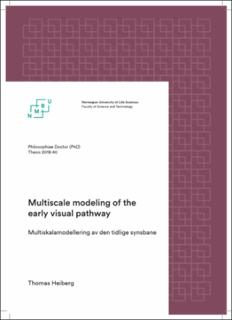| dc.contributor.advisor | Plesser, Hans Ekkehard | |
| dc.contributor.advisor | Einevoll, Gaute | |
| dc.contributor.author | Heiberg, Thomas | |
| dc.date.accessioned | 2021-12-15T12:07:02Z | |
| dc.date.available | 2021-12-15T12:07:02Z | |
| dc.date.issued | 2018 | |
| dc.identifier.isbn | 978-82-575-1512-6 | |
| dc.identifier.issn | 1894-6402 | |
| dc.identifier.uri | https://hdl.handle.net/11250/2834425 | |
| dc.description.abstract | The human brain contains billions of neurons connected through synapses, making it a highly complex system that researchers have been trying to understand for centuries. One way of increasing our understanding of the brain is through modeling. Different modeling techniques and tools support modeling at different levels of scale, from biophysically detailed models of specific properties in single neurons to large-scale population models where the rate of action-potential firing is modeled.
Vision is by far the most important sense for humans and a large fraction of the brain’s capacity is engaged in visual perception. The retina, the lateral geniculate nucleus (LGN) and the primary visual cortex comprise the first few steps in visual processing and are collectively known as the early visual pathway. The thalamus, of which the LGN is a part, has been said to represent “the final bottleneck of information flow before it gets into cortex”. It has mostly been thought of as a relay station for sensory signals on the way to cortex, but with its central position in the brain right on top of the brainstem, it seems to be a natural location to perform filtering and modulation of the sensory signals based on attention and other behavioral requirements.
A central theme of this thesis is to extend our understanding of the signal processing in the early visual pathway through modeling and to bridge the gap between biology and models at different levels of scale. Three main topics are addressed: First, we investigate how spiking point-neuron models relate to firing-rate models at the retinogeniculate synapse. With two spiking neuron models as the starting point of our analysis, we study how well firing-rate models capture the essential response properties of LGN relay cells. Second, we apply the same approach to more complex neuron models that can be parameterized to exhibit a wide range of different spiking patterns and thereby can be configured to represent many different neuron types in the early visual system and elsewhere in the brain. Finally, we explore the effects of different inhibitory actions from local interneurons on the relay cells in a biophysically detailed network model of the LGN circuit. Large- scale parameter scans are central to all three projects. They are managed efficiently by support tools developed as part of this work.
Although the models and findings presented here may have taken our understanding a small step forward, the early visual pathway and the brain in general is still far from understood. Hence, we hope that these results will prove useful as starting points for future investigations. | en_US |
| dc.description.abstract | Menneskehjernen består av flere milliarder nevroner som er koblet sammen via synapser. Resultatet er et komplekst system som forskere har forsøkt å forstå i en årrekke. En frem- gangsmåte for å øke forståelsen av hjernen, er å benytte seg av modellering. Forskjellige modelleringsteknikker og -verktøy støtter modellering på forskjellige nivåer, fra detaljerte biofysiske modeller av enkeltnevroner i den ene enden av skalaen til fyringsratemodeller for populasjoner av nevroner i den andre.
Synet er uten tvil den viktigste av menneskets sanser og en stor del av hjernen benyttes til å behandle synsinntrykk. Netthinnen bakerst i øyet, LGN (“lateral geniculate nucleus”) og det primære synssenteret i hjernebarken utgjør de første stegene i synsprosesseringen og omtales gjerne som den tidlige synsbane. Thalamus, som LGN er en del av, har blitt omtalt som “den siste flaskehalsen i informasjonsflyten inn til hjernebarken”. Den har stort sett blitt ansett som kun en reléstasjon for signaler på vei til hjernebarken, men med sin sentrale plassering på toppen av hjernestammen, fremstår dette som et naturlig sted for filtrerering og modulering av signaler fra sansene.
Hovedmålet med denne avhandlingen er å øke vår forståelse av prosesseringen som foregår i den tidlige synsbane gjennom modellering og å bygge bro mellom biologien og mod- eller på forskjellige detaljeringsnivåer. Vi tar for oss tre temaer: Først undersøker vi i hvilken grad punktnevnronmodeller av reléceller i LGN kan forenkles til fyringsrate- modeller. Vi tar utgangspunkt i to eksisterende punktnevnronmodeller som vi tilpasser forenklede fyringsratemodeller til og sammenligner simuleringsresultater fra de to modell- typene. Videre benytter vi samme fremgangsmåte for å analysere mer komplekse nevron- modeller som kan tilpasses mange forskjellige adferdsmønstre. Til slutt bygger vi en biofysisk detaljert nettverksmodell av LGN-kretsen for å undersøke hvordan forskjellige typer inhibisjon fra lokale internevroner påvirker relécellene. Nødvendige støtteverktøy utvikles underveis for å understøtte storskala parametersøk som står sentralt i alle tre prosjektene.
Modellene og funnene som presenteres her bidrar forhåpentligvis til å ta vår forståelse av hjernen et lite steg videre. Samtidig gjenstår det fortsatt mye før den tidlige synsbane og hjernen generelt er fullt ut forstått. Vi håper derfor at disse resultatene også kan danne et godt utgangspunkt for fremtidige undersøkelser. | en_US |
| dc.description.sponsorship | The Research Council of Norway | en_US |
| dc.language.iso | eng | en_US |
| dc.publisher | Norwegian University of Life Sciences, Ås | en_US |
| dc.relation.ispartofseries | PhD Thesis;2018:40 | |
| dc.rights | Attribution-NonCommercial-NoDerivatives 4.0 Internasjonal | * |
| dc.rights.uri | http://creativecommons.org/licenses/by-nc-nd/4.0/deed.no | * |
| dc.subject | LGN | en_US |
| dc.subject | Multiscale modeling | en_US |
| dc.subject | Thalamus | en_US |
| dc.title | Multiscale modeling of the early visual pathway | en_US |
| dc.title.alternative | Multiskalamodellering av den tidlige synsbane | en_US |
| dc.type | Doctoral thesis | en_US |

